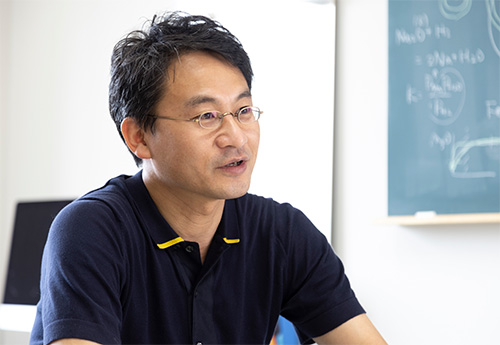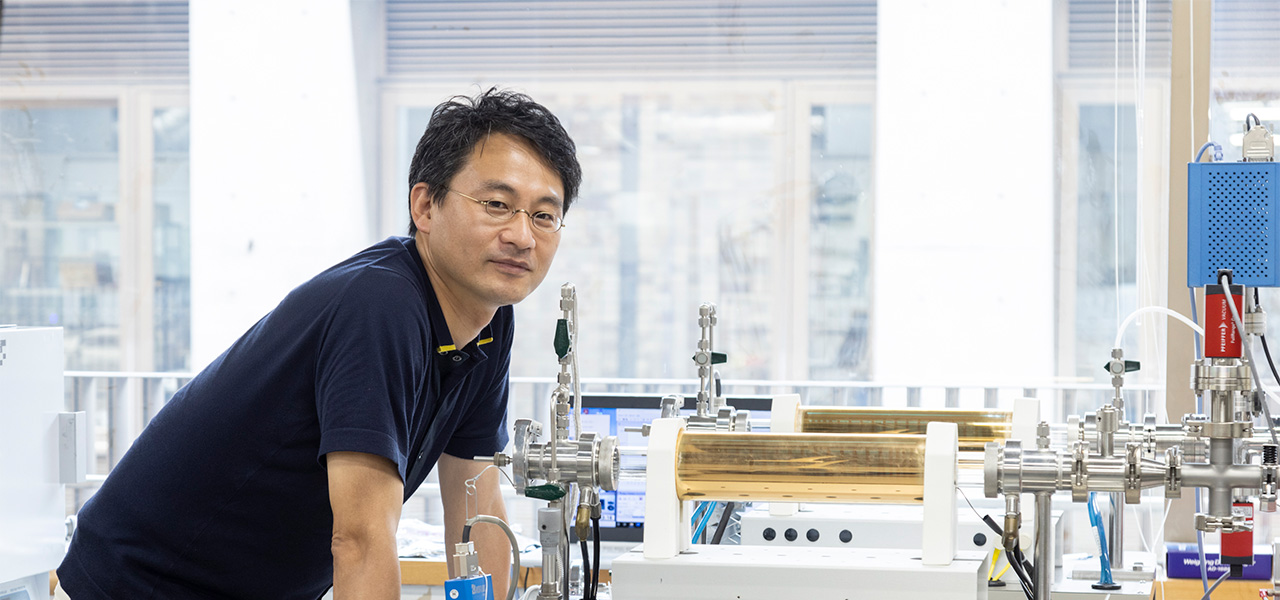
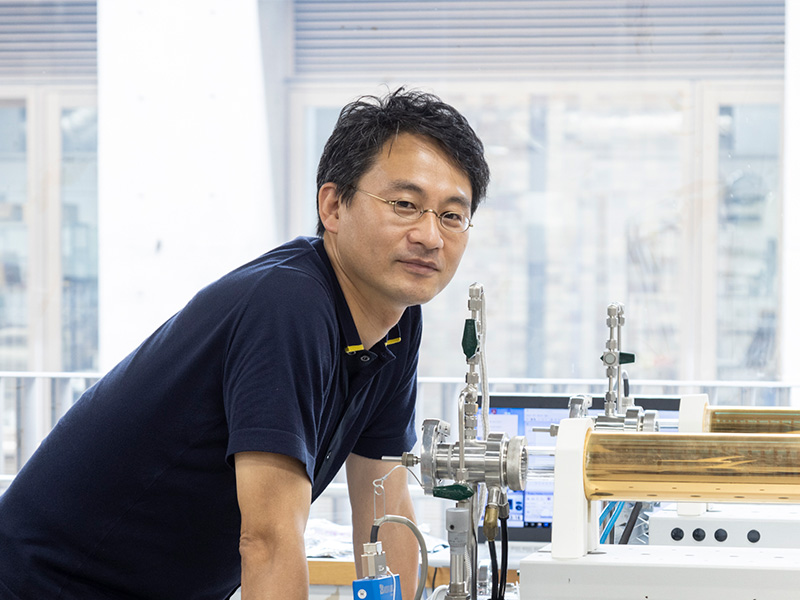
Special Interview Vol.2


Special Interview Vol.2
Shogo Tachibana
Professor, UTokyo Organization for Planetary and Space Science, Graduate School of Science, The University of Tokyo / Specially Appointed Professor, Institute of Space and Astronautical Science (JAXA) / Head of Initial Analysis
Born in 1973 in Ishikawa Prefecture, Japan, he earned a Ph.D. in 2000 from the Department of Earth and Space Science, Graduate School of Science, Osaka University, and worked as an assistant professor in the Department of Earth and Planetary Science, Graduate School of Science, The University of Tokyo, and as an associate professor in the Department of Natural History Sciences, Graduate School of Science, Hokkaido University, before assuming his current position. He has received numerous awards, both in Japan and abroad, including the Nier Prize from the Meteoritical Society, a Goldschmidt Conference Paul W. Gast Lectureship, and a Best Researcher Award from the Japanese Society for Planetary Sciences. His publications include “Memories of Stardust: Stories from the Galaxy to the Solar System” (Iwanami Science Library) and “Earth, Planets, and Life” (co-editor) (University of Tokyo Press) (both available in Japanese only).
In June 2021, initial analysis of the material samples collected by the Hayabusa2 explorer mission from the asteroid “Ryugu” began. This analysis is expected to bring us closer to understanding the birth of the solar system and the origins of life.
In this second installment of special interviews, we talk to Prof. Shogo Tachibana, who has led the Initial Analysis Team, made up of about 270 scientists. We asked him about his initial analysis work and his thoughts about the research as a scientist. (The interview was conducted in August 2021)
The earliest examination work on the Hayabusa2 Project began in 2006, but I only got fully involved in the project in 2009. So, the past 12 years have been quite restless for me.
When the project was starting, we had to persuade the government and researchers about the value of the mission. Then we had to develop the equipment to collect the samples before the take-off of the Hayabusa2 probe, as well as prepare to pick up the sample capsule when it returned to Earth. So, it’s been a very hectic time.
We accomplished our mission of bringing back samples from the asteroid Ryugu to Earth, but from the standpoint of scientists who are involved in the analysis, the real work is just happening now.
I’ve been working on the project for about 12 years now, but as of June 2021, I have less than a year left with it.
It’s like the life cycle of a cicada. After living underground for years, it finally emerges from the ground to become an adult. This is the year that I’ve really looked forward to. It’s been busy and tough at times, but it’s also been enjoyable and exciting every day.
We actually started making trips to Australia in 2018 to prepare for the capsule recovery. We studied the local climate and the hardness of the soil around the expected landing site.
The day after the safe return of the capsule, we stayed in Australia to extract the gas from inside the sample container, which contained sand and stones from Ryugu, by drilling holes in the bottom of it. We then returned to open the container here in Japan. Since the Earth’s atmosphere is about 21% oxygen, opening the sealed sample container in a normal way could produce oxidation of the sand and stones from Ryugu, which would change their properties. For this reason, all the opening work was done in a vacuum chamber without using human hands.
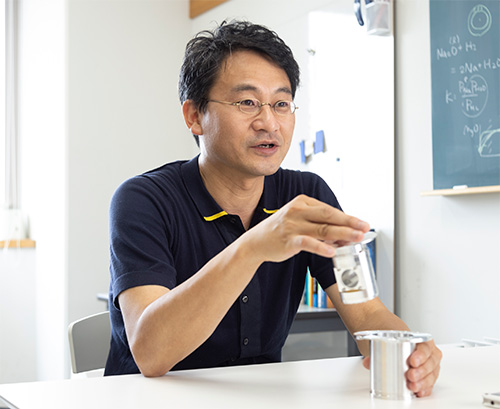
Professor Tachibana with a sample container
I felt that we had taken another step forward to the next stage.
Naturally, I’m very pleased, but I’m a lead of sample science with a lot of responsibility. So, I feel quite nervous at every milestone of the project. It is the same at the time of take-off, when Hayabusa2 landed on Ryugu, and when the capsule returned to Earth. Every time, I feel like the next stage is about to begin.
The goal of this project is to find out where the water that makes up the Earth’s oceans came from and where the materials of life were formed. JAXA (Japan Aerospace Exploration Agency) has announced that the samples probably contain water and organic matter, as we had hoped. Right now, we are investigating the details from different angles and carrying on discussions among researchers. We are making good progress.
We are conducting wide-ranging analyses of the samples from Ryugu, to figure out the types and amounts of elements, crystal structures, and the gas components they contain. We are working on the analysis day by day, looking forward to what we will ultimately discover. The initial analysis is continuing for a year from June 2021, but within a year we hope to report the first findings.
Various models have been proposed for explaining how water came to be formed on Earth. One of the most favored theories is that water and organic matter were transported to Earth with C-type asteroids, but this is based on the hypothesis that C-type asteroids* contain water and carbon. I say this because nobody really knows what a C-type asteroid is exactly.
Now that we will be able to reveal the true nature of C-type asteroids for the first time, we can test the validity of these various theories. At the same time, new hypotheses will probably emerge. It is therefore very important that the analysis results can provide clear and solid evidence.
Our aim with the initial analysis is to investigate and record the chemical composition of samples, such as the amounts of various elements and types of minerals they contain. The analysis is done without any preconceptions, from various angles and with high precision. We also want to verify whether water and organic matter, the basic substances that creates life, exist in outer space, and whether celestial bodies such as Ryugu may have brought these substances to Earth.
This analysis will not reveal everything about the origin of the solar system, but it will hopefully take one step closer to clearing up this mystery.
* C-type asteroid: A celestial body believed to contain water, carbon, and other organic matter remaining from approximately 4.6 billion years ago when the solar system was formed. Analysis of the C-type asteroid Ryugu is expected to offer important clues to the origins of the solar system and the beginnings of life on Earth.
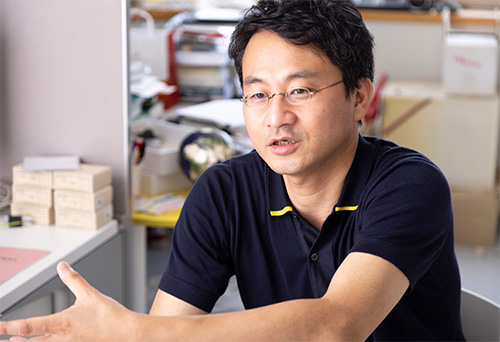
My interest in space started in the first or second grade of elementary school. At that time, the space probe Voyager was sending back pictures of Jupiter and Saturn. For some reason I drew pictures of the planets on a folder I used to keep the letters handed out at school. I had fun using a variety of colored pencils. That was when I wondered why planets were of different colors.
I know now that it is due to the differences in materials on each planet, but back then it was a complete mystery to me.
Later, I decided that I wanted to study planets, so when I went on to university, I elected to study subjects related to the materials that make up planets, because they were what I wondered as a child and what I wanted to research.
Initially, I did not really want to pursue a career in research, but after enjoying my graduation research work at the university and receiving encouragement from my supervisor, I ended up becoming a researcher.
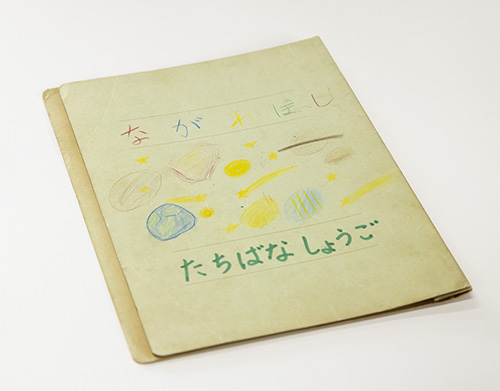
A folder on which Prof. Tachibana drew pictures of the solar system as an elementary school student.
Having fun and being imaginative. I often tell students that they should enjoy themselves.
However, before you can enjoy yourself, you have to get over many hurdles. And you need to rely on your own strength to jump over them, which can be difficult.
I see studying and research as two different things. Studying is about deeply absorbing what is already known so that you can output it accurately. Research, on the other hand, is about increasing what is known, which involves a lot of suffering. There are no answers written anywhere, and there is no one who can tell you the answers. But the process of finding the answers yourself is fun, even if you keep making mistakes over and over.
To study extraterrestrial materials, you have to ponder over the origins of the solar system, using your imagination but always basing yourself on scientific facts. It is a different world from mathematics, and it also includes an element of history.
You need to think comprehensively, drawing from a wide variety of information, and it’s important to occasionally imagine many possibilities.
I am often pressed for time these days, but I want to consciously set aside time for this kind of fantasizing. This process allows ideas to mature and take shape in my mind.
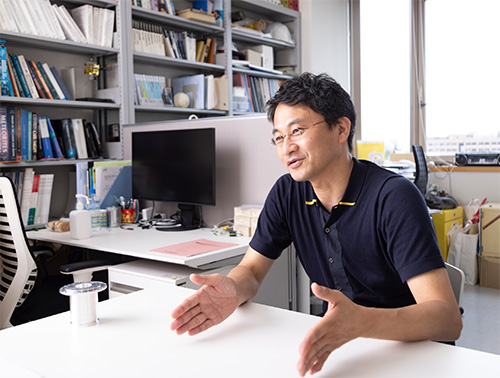
As I see it, analyzing matter to obtain information is a vital aspect of research.
When you closely consider the origin of the solar system and the formation of the planets, there are obviously some things that cannot be penetrated by imagination alone. In this sense, analysis serves as solid evidence and as a base for further expanding our imagination. It is very important, therefore, that in the initial analysis we describe nature as it is, without any subjectivity.
I encourage students to give a lot of importance to their school studies.
In my view as a person getting involved in research, studying only science cannot make you a true scientist.
Extraterrestrial materials are a deep and broad field of science, encompassing physics, chemistry, mathematics, biology, and other elements. I was once asked by an overseas researcher why there were no more Samurai in Japan. To communicate with researchers around the world, you need to understand not only foreign languages, but also cultural differences and Japanese history. These are the things that are taught in school.
I would also urge you to plant seeds of “wonder” and “curiosity” inside yourselves.
In my case, I wondered why the planets were of different colors. That seed, planted so long ago, eventually sprouted and grew big. And here I am!
It makes no difference whether you are curious about the sky, the ground, rivers, or anything else. Just plant a lot of seeds of curiosity.
I want you to know that thinking about things that you don’t understand, even after asking the teacher, is a good thing to do.
There are so many things that teachers don’t understand either. I still don’t understand the whole picture concerning the origins of the solar system and the beginnings of life. Even after a lifetime of study, I probably won’t have all the answers. Nonetheless, the process of confronting such a difficult challenge is both enjoyable and valuable.
